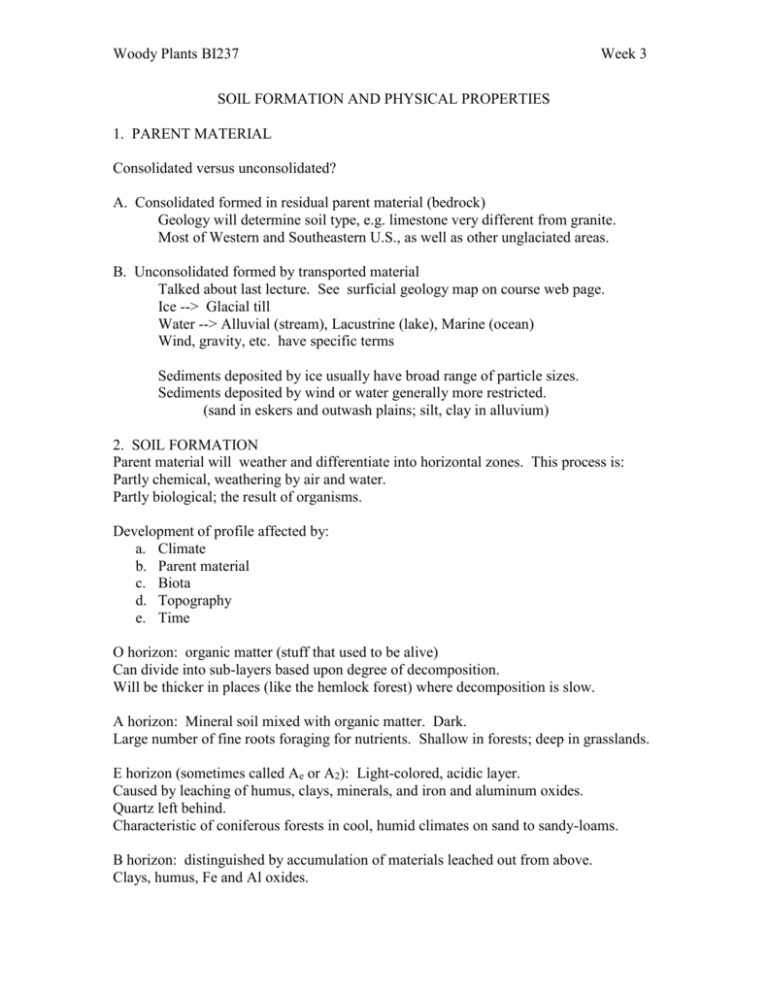Lecture notes on physical properties of soil
advertisement

Woody Plants BI237 Week 3 SOIL FORMATION AND PHYSICAL PROPERTIES 1. PARENT MATERIAL Consolidated versus unconsolidated? A. Consolidated formed in residual parent material (bedrock) Geology will determine soil type, e.g. limestone very different from granite. Most of Western and Southeastern U.S., as well as other unglaciated areas. B. Unconsolidated formed by transported material Talked about last lecture. See surficial geology map on course web page. Ice --> Glacial till Water --> Alluvial (stream), Lacustrine (lake), Marine (ocean) Wind, gravity, etc. have specific terms Sediments deposited by ice usually have broad range of particle sizes. Sediments deposited by wind or water generally more restricted. (sand in eskers and outwash plains; silt, clay in alluvium) 2. SOIL FORMATION Parent material will weather and differentiate into horizontal zones. This process is: Partly chemical, weathering by air and water. Partly biological; the result of organisms. Development of profile affected by: a. Climate b. Parent material c. Biota d. Topography e. Time O horizon: organic matter (stuff that used to be alive) Can divide into sub-layers based upon degree of decomposition. Will be thicker in places (like the hemlock forest) where decomposition is slow. A horizon: Mineral soil mixed with organic matter. Dark. Large number of fine roots foraging for nutrients. Shallow in forests; deep in grasslands. E horizon (sometimes called Ae or A2): Light-colored, acidic layer. Caused by leaching of humus, clays, minerals, and iron and aluminum oxides. Quartz left behind. Characteristic of coniferous forests in cool, humid climates on sand to sandy-loams. B horizon: distinguished by accumulation of materials leached out from above. Clays, humus, Fe and Al oxides. Woody Plants BI237 Week 3 Usually reddish due to oxidized iron oxides (Fe3+). Can have blue-gray splotches resulting from saturated soil, especially if clay-ey. Oxygen in wet soil will be depleted by the respiration of roots and soil organisms. Iron will be reduced (Fe2+). Looks blue-gray. Sometimes get blue & orange splotches where fluctuating water table occurs over clay hardpan. High-water tables can restrict the rooting depth of trees. Prone to windthrow. C horizon: parent material. Unchanged by leaching, deposition. You can find pictures of soil profiles by going to the image search on google. A search on “soil profile podzol” will bring up sandy coniferous forest profiles with a prominent E horizon. 3. SOIL TEXTURE (see accompanying handout) 4. SOIL WATER Water "pulled" from plant by transpiration. (More on this later when we study anatomy & physiology) Stomata in leaves need to open to let CO2 in for photosynthesis. As long as relative humidity in the air is <100%, water will flow from the plant into the air. Cohesion between water molecules, pulled through plant, through roots, from soil. Water also attracted to soil particles (adhesion) The closer it is to the particle, the stronger it is held. Gravity, evaporation, transpiration will reduce water held in soil. As you get to the "skin" of water around soil particles, the "pull" from the tree may not be strong enough to pull water out of soil. Can reach permanent wilting point. Available water strongly influenced by soil texture. Clay holds almost 2.5 X more water per volume than does sand. Loam, silt loam, and clay loam have lots of available water.





